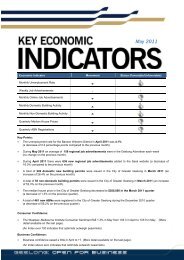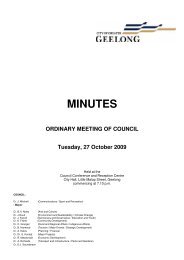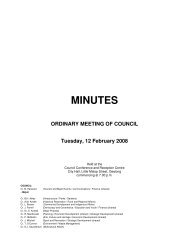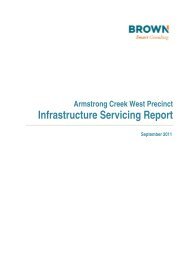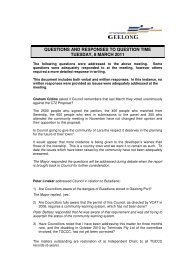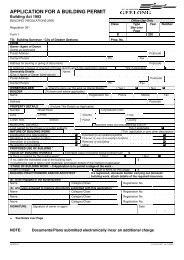ANNUAL REPORT 2007-2008 CITY OF GREATER GEELONG
ANNUAL REPORT 2007-2008 CITY OF GREATER GEELONG
ANNUAL REPORT 2007-2008 CITY OF GREATER GEELONG
Create successful ePaper yourself
Turn your PDF publications into a flip-book with our unique Google optimized e-Paper software.
<strong>CITY</strong> <strong>OF</strong> <strong>GREATER</strong> <strong>GEELONG</strong><br />
NOTES TO THE FINANCIAL <strong>REPORT</strong> FOR THE YEAR ENDED 30 JUNE <strong>2008</strong><br />
36 Financial Instruments (cont’d)<br />
(e) Risks and Mitigation (cont’d)<br />
Interest Rate Risk<br />
Interest rate risk refers to the risk that the fair value of a financial instrument or cash flows associated with the instrument will fluctuate due to changes in market interest rates. Interest<br />
rate risk arises from interest bearing financial assets and liabilities that we use. Non derivative interest bearing assets are predominantly short term liquid assets. Our interest rate liability<br />
risk arises primarily from long term loans and borrowings at fixed rates which exposes us to fair value interest rate risk.<br />
Our loan borrowings are sourced from major Australian banks by a tender or quoting process. Overdrafts are arranged with major Australian banks. We manage interest rate risk on<br />
our net debt portfolio by:<br />
> ensuring access to diverse sources of funding;<br />
> reducing risks of refinancing by managing in accordance with target maturity profiles; and<br />
> setting prudential limits on interest repayments as a percentage of rate revenue.<br />
We manage the interest rate exposure on our net debt portfolio by appropriate budgeting strategies and obtaining approval for borrowings from the Australian Loan Council each year.<br />
Investment of surplus funds is made with appropriate financial institutions under the Local Government Act 1989. We manage interest rate risk by adopting an investment policy<br />
that ensures:<br />
> conformity with State and Federal regulations and standards,<br />
> adequate safety,<br />
> appropriate liquidity,<br />
> diversification by credit rating, financial institution and investment product,<br />
> monitoring of return on investment,<br />
> benchmarking of returns and comparison with budget.<br />
Maturity will be staggered to provide for interest rate variations and to minimise risk.<br />
Credit Risk<br />
Credit risk is the risk that a contracting entity will not complete its obligations under a financial instrument and cause us to make a financial loss. We have exposure to credit risk on<br />
all financial assets included in our balance sheet. To help manage this risk:<br />
> we have a policy for establishing our credit limits for the entities that we deal with;<br />
> we may require collateral where appropriate; and<br />
> we only invest surplus funds with financial institutions which have a recognised credit rating specified in our investment policy.<br />
Trade and other receivables consist of a large number of customers, spread across the consumer, business and government sectors. We do not have any significant credit risk exposure<br />
to a single customer or groups of customers. Ongoing credit evaluation is performed on the financial condition of our customers and, where appropriate, an allowance for doubtful debts is<br />
raised.<br />
We may also be subject to credit risk for transactions which are not included in the balance sheet, such as when we provide a guarantee for another party. Details of our contingent<br />
liabilities are disclosed in note 35.<br />
178




